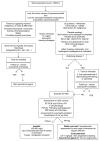Practical approach to the patient with hypereosinophilia
- PMID: 20538328
- PMCID: PMC2902584
- DOI: 10.1016/j.jaci.2010.04.011
Practical approach to the patient with hypereosinophilia
Abstract
Markedly increased blood eosinophilia (ie, > or =1.5 x 10(9)/L), whether discovered fortuitously or found with signs and symptoms of associated organ involvement, commands diagnostic evaluation and often therapeutic interventions. This degree of hypereosinophilia is often but not uniformly associated with eosinophilic infiltration of tissues that can potentially lead to irreversible, life-threatening organ damage. Initial approaches focus on ascertaining that eosinophilia is not secondary to other underlying disease processes, including helminthic parasite infections, varied types of adverse reactions to medications, and other eosinophil-associated syndromes, such as eosinophilic gastroenteritides, eosinophilic pneumonias, and Churg-Strauss syndrome vasculitis. If evaluations exclude eosinophilia attributable to secondary causes or other eosinophil-related syndromes or organ-specific diseases, attention must be directed to considerations of varied other forms of the hypereosinophilic syndromes, which include myeloproliferative variants, lymphocytic variants, and many of still unknown causes. Cognizant of the capacities of eosinophils to mediate tissue damage, the varied causes for hypereosinophilia are considered, and a contemporary stepwise practical approach to the diagnosis and treatment of patients with hypereosinophilia is presented.
Copyright 2010 American Academy of Allergy, Asthma & Immunology. Published by Mosby, Inc. All rights reserved.
Figures
References
-
- Bousquet J, Chanez P, Lacoste JY, Barneon G, Ghavanian N, Enander I, Venge P, Ahlstedt S, Simony-Lafontaine J, Godard P, Michel FB. Eosinophilic inflammation in asthma. N Engl J Med. 1990;323:1033–1039. - PubMed
Publication types
MeSH terms
Grants and funding
LinkOut - more resources
Full Text Sources


